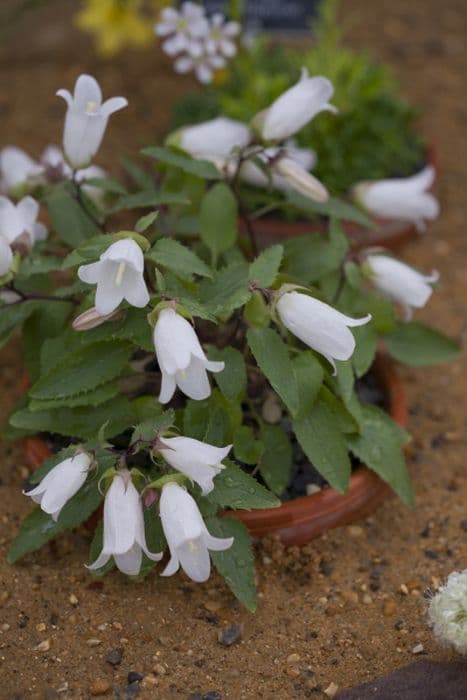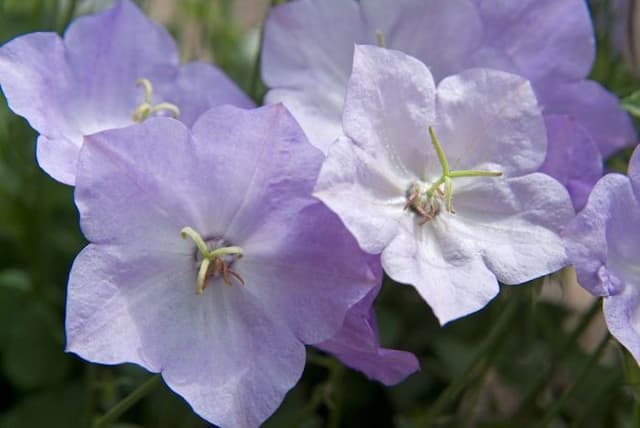Blue Star Creeper Isotoma 'Avant-garde Blue'

ABOUT
Isotoma 'Avant-garde Blue' boasts a striking appearance with its vibrant blue blooms that are star-shaped and provide a lush accent in any garden space. Its flowers are noted for their five-pointed form and radiant hue, which is a highlight of its ornamental value. The plant's foliage is finely textured, adding a delicate and feathery backdrop to the showy blossoms. The leaves are typically green, contributing to the plant's overall lush and vibrant look. The contrast between the foliage and the blue flowers creates an eye-catching display that captures attention through its simplicity and color depth. The overall shape of Isotoma 'Avant-garde Blue' gives it a compact and mounded form, which adds to its versatility in different garden designs or as a potted specimen. Its blossoming season provides an extended period of visual interest, with the blue colors standing out in a sea of greenery. The plant is appreciated for both its aesthetic appeal and its easy-care nature, making it a favorite among garden enthusiasts looking for a splash of color.
About this plant
 Names
NamesFamily
Campanulaceae
Synonyms
Blue Star Creeper, Blue Isotoma
Common names
Isotoma 'Avant-garde Blue'.
 Toxicity
ToxicityTo humans
Isotoma 'Avant-garde Blue', commonly known as Blue Star, does not have a well-documented profile with regard to its toxicity to humans. Currently, there is limited information available on the specific toxic compounds present in this plant or on the symptoms that may arise following ingestion. However, as with many ornamental plants, it is generally wise to exercise caution and avoid ingesting any part of the plant due to potential unknown toxicities.
To pets
Blue Star, the common name for Isotoma 'Avant-garde Blue', is not specifically listed as toxic to pets, such as dogs and cats. However, the absence of information or documented cases of poisoning does not necessarily guarantee that a plant is non-toxic to animals. Since detailed toxicity data may be unavailable, it is advisable to prevent pets from ingesting this plant, and monitor for any signs of illness if ingestion occurs, consulting a veterinarian as necessary.
 Characteristics
CharacteristicsLife cycle
Perennials
Foliage type
Evergreen
Color of leaves
Green
Flower color
Blue
Height
1 foot [30 cm]
Spread
1 foot [30 cm]
Plant type
Herb
Hardiness zones
9
Native area
Australia
Benefits
 General Benefits
General Benefits- Attractive Flowers: Isotoma 'Avant-garde Blue', commonly known as Blue Star, produces vivid blue star-shaped flowers that add a splash of color to gardens and landscapes.
- Drought Tolerance: Once established, Blue Star has good drought tolerance, making it suitable for xeriscaping and low-water gardens.
- Low Maintenance: It typically requires minimal care, making it a great option for gardeners who desire beautiful garden displays but have limited time for upkeep.
- Attracts Pollinators: The flowers attract bees, butterflies, and other beneficial pollinators, promoting biodiversity in the garden.
- Long Blooming Period: Blue Star offers a lengthy blooming season, providing a long-term display of color from late spring to fall.
- Compact Growth: With its mounding habit, this plant stays compact, which is ideal for small spaces, border fronts, rock gardens, and containers.
 Medical Properties
Medical PropertiesThis plant is not used for medical purposes.
 Air-purifying Qualities
Air-purifying QualitiesThis plant is not specifically known for air purifying qualities.
 Other Uses
Other Uses- Photographic subjects: The vibrant blue flowers of the Blue Star are excellent for macro photography, showcasing the intricate details and natural beauty of the plant.
- Themed gardens: Blue Star can be incorporated into blue-themed gardens or patriotic red, white, and blue displays, celebrating national holidays with its bright blue petals.
- Craft projects: Dried Blue Star flowers can be used in crafting, such as making bookmarks, pressed flower art, or in homemade potpourri blends.
- Educational tool: Blue Star can serve as a hands-on tool for teaching children about plant biology, pollination, and the lifecycle of a flower.
- Artistic inspiration: The distinctive color and form of this plant can inspire artists and designers seeking natural themes and color palettes for their work.
- Event decor: Fresh or dried Blue Star flowers can be used to decorate tables and venues for special events, adding a natural elegance.
- Color dye: Though not commonly done, the Blue Star could potentially be used to make a natural dye for fabrics or craft papers, though the results may vary.
- Fairy gardens: Due its compact size, the Blue Star is perfect for inclusion in miniature fairy garden designs.
- Culinary garnish: Although not known for culinary use, the non-toxic flowers could be used as a colorful garnish for salads and desserts to add an unexpected pop of color.
- Eco-friendly confetti: Dried Blue Star petals can be used as a biodegradable confetti alternative for outdoor celebrations.
Interesting Facts
 Feng Shui
Feng ShuiBlue Star Creeper is not used in Feng Shui practice.
 Zodiac Sign Compitability
Zodiac Sign CompitabilityBlue Star Creeper is not used in astrology practice.
 Plant Symbolism
Plant Symbolism- Innovation: The term 'Avant-garde' in Isotoma 'Avant-garde Blue' suggests novelty and being ahead in trends. This plant can symbolize the desire to innovate and pave new paths.
- Serenity: The blue color is often associated with calmness and tranquility. This plant may represent peace and the ability to soothe the soul.
- Depth: Blue is a color that evokes depth, such as the sea or sky. Therefore, the plant could symbolize a profound nature or deep emotions.
- Creativity: Its distinctive coloring and unique appearance could make it a symbol of creativity and artistic expression.
 Water
WaterThe Blue Star Creeper should be watered thoroughly once the top inch of soil feels dry to the touch, typically every week or as needed depending on the environmental conditions. It's important to avoid overwatering, which can lead to root rot. Provide enough water to moisten the soil evenly throughout the pot without letting the plant sit in water. Using room temperature water, apply approximately 16 ounces for a small pot, increasing the amount proportionally for larger pots, ensuring even distribution around the plant, every 7 to 10 days during active growing seasons.
 Light
LightThe Blue Star Creeper thrives in partial to full sunlight. The ideal spot for this plant would be a location where it receives bright, indirect light for most of the day, with some direct sun in the mornings or late afternoons. Avoid intense, direct sunlight during peak hours as it may scorch the foliage.
 Temperature
TemperatureBlue Star Creeper prefers moderate temperatures and can survive in a range between 50 to 85 degrees Fahrenheit. The ideal temperature conditions for this plant are between 60 to 75 degrees Fahrenheit. Extreme cold or heat beyond these ranges could harm the plant.
 Pruning
PruningPrune the Blue Star Creeper to maintain its shape and encourage denser growth. It's best to prune in the spring, just before new growth begins, or after it flowers to tidy its appearance. Regularly trim back any overly long stems or damaged foliage using clean, sharp scissors, doing so every few months or as necessary.
 Cleaning
CleaningAs needed
 Soil
SoilBlue Star Creeper thrives in moist, well-draining soil with a pH of 5.5 to 6.5. A mixture of peat, perlite, and sand works well to create the ideal environment for its roots, ensuring good aeration and moisture retention.
 Repotting
RepottingBlue Star Creeper should be repotted every 2-3 years to replenish the soil and provide room for growth. Use fresh potting mix and a slightly larger pot each time.
 Humidity & Misting
Humidity & MistingBlue Star Creeper prefers moderate humidity levels but is quite adaptable. Aim for humidity around 40-50% for optimal growth, avoiding excessively dry conditions.
 Suitable locations
Suitable locationsIndoor
Place Blue Star Creeper in bright, indirect light and maintain consistent moisture.
Outdoor
Plant Blue Star Creeper in part shade to full sun with moist soil.
Hardiness zone
9-11 USDA
 Life cycle
Life cycleIsotoma 'Avant-garde Blue', commonly known as Blue Star Creeper, begins its cycle when its seeds germinate in moist, well-draining soil with light exposure. Upon sprouting, the seedlings develop into a low mat of green foliage, which is followed by the growth of slender, branching stems. As the stems grow, they bear small, star-shaped blue flowers, typically blooming in late spring or early summer, which also attracts pollinators. After pollination, the flowers produce small capsules containing seeds, completing the reproductive stage. The plant may then go dormant in regions with cold winters, conserving energy below the ground. In the following spring, the Blue Star Creeper will resume growth from the root system, repeating its lifecycle and possibly spreading through self-seeding and vegetative propagation.
 Propogation
PropogationPropogation time
Spring-Early Summer
The Isotoma 'Avant-garde Blue', commonly known as Blue Star Creeper or Laurentia, is frequently propagated through stem cuttings, a method favored for its simplicity and effectiveness. To propagate by stem cuttings, select a healthy, non-flowering shoot during the plant's active growth season, typically in spring or early summer. Cut a 3 to 4 inch (approximately 7.5 to 10 cm) portion of the stem just below a leaf node, and remove the leaves from the lower half of the cutting. Dipping the cut end into rooting hormone can encourage root development, although it's not strictly necessary. Plant the cutting in a well-draining potting mix, ensuring that the leafless portion of the stem is buried. Keep the soil consistently moist but not waterlogged and in a warm environment with indirect sunlight. Roots typically form within a few weeks, after which the new plant can eventually be transplanted outdoors or into a larger pot.









![Milky bellflower [Avalanche]](/_next/image?url=https%3A%2F%2Fplants-admin.emdemapps.com%2Fimages%2Fplants%2F%2Fimages%2F604b5dc88c1e7.png&w=640&q=75)